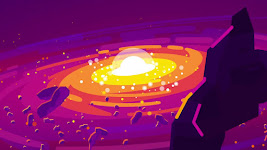The Milky Way
At night time one could see a faint glow stretching over the sky, It's brighter in some spots than the others. As this glow is that of a dull white, ancient Greeks called it the "Galaxius". In this modern era it is known as the "Milky way galaxy".
One day a scientist named Galileo observed the faint nebulous glow and to his astonishment it was made up of stars, thousands of them. They blended together to form the faint nebulous glow that one could observe in the night sky. Clearly there were far more stars in the sky than the 6000 that is visible to our unaided eye. Astronomers reasoned that counting the stars in the sky could reveal the shape of the Milky way galaxy. Over the centuries maps were made this way which revealed the galaxy to be oval shaped or like a flattened disc and the sun was thought to be near the center of the galaxy. But this method of star counting didn't account for interstellar dust which absorbs light, making it difficult to determine the shape. It is more like a smoky room where one would think the room is small than it really is. It may look like we are in the center of the room, but we may be beside the wall.
Globular clusters(spherical balls of stars) orbit the main body of the galaxy. If we were near the center of the galaxy we should have observed the globular clusters being evenly distributed, but that wasn't the case.
There were more stars in side of the sky than the other. But they were indeed evenly distributed and we were the ones off the center.
From measurements scientists were able to determine the distance of the sun from the center of the galaxy to be 25,000 light years. So at this point things were coming together. The Milky way must be a flattened disk, with a bulge in the middle. The sun is in that disk, far from the center.
Does it have structure in it, or is it more like a smooth flat plate?
That's hard to determine as dust severely restricts our view. But with the help of radio astronomy we figured that out too. An amazing result was found.
The locations of these nebulae indicated that the disk of the Milky Way was divided into "Spiral arms"- Huge,sweeping,curving arms that were tens of thousands of light years long. Interestingly, all the young, massive, bright stars appeared to be in these spiral arms too, with none in the apparent gaps between the arms.
Like all stars,these massive ones form in giant nebulae,but unlike most stars they don't live very long before exploding as supernovae. If most
nebulae are in the arms, then these massive stars will be too. Recent studies reveal that there are four arms around the milky way galaxy.
Our Sun is located just outside a smaller arm called the "Orion arm".
In the very center of the galaxy sits a supermassive black hole having four million times the mass of the sun.
The last component of the milky way is it's halo, a vast spherical cloud of stars surrounding it out to great distance more than 100,000 light years. We don't know much about the halo but we know that the stars in it are old. No star formation occurs there. It's possible some stars in the halo formed there, while others
were flung out into the halo after collisions with other stars in clusters. Most of the globular clusters orbiting
the Milky Way are in the halo. There are more than 150 in total.
So that's all about the Milky way.
Is Milky way the galaxy, or a galaxy?
Let's find out in the next blog about galaxies.



Nice!!
ReplyDeleteRlyy intersting!! Looking forward for d next blogg!!!
ReplyDeleteThanks and btw there is a sequel to this blog named Galaxies.Do watch it 👍
DeleteShuuureeeee
Delete